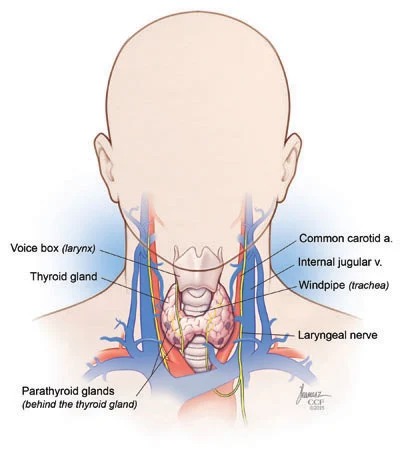
Parathyroid adenoma is a small, benign tumor that develops in one of the parathyroid glands. There are typically four parathyroid glands, which are small glands located in the neck, near or attached to the back side of the thyroid gland. These glands produce parathyroid hormone (PTH), which helps control the levels of calcium and phosphorus in the body. When an adenoma develops, it can lead to overproduction of PTH, a condition known as hyperparathyroidism. This can result in high levels of calcium in the blood, potentially causing kidney stones, bone loss, and other health problems.
Parathyroid adenoma surgery, known as parathyroidectomy, is often the recommended treatment for this condition. Here’s a general overview of the process:
Preoperative Preparation: Before surgery, you will undergo a series of tests to confirm the diagnosis, identify the location of the adenoma, and assess your overall health. This may include blood tests, imaging studies such as ultrasound or sestamibi scan, and possibly a CT scan or MRI.
The Surgical Procedure: Parathyroidectomy is typically performed under general anesthesia, meaning you will be asleep during the procedure. The surgeon makes an incision in the neck to access the parathyroid glands. Using information from preoperative imaging and intraoperative PTH monitoring, the surgeon identifies and removes the adenoma. The remaining normal parathyroid glands are left in place.
Intraoperative PTH Monitoring: This is a technique used during surgery to confirm that the adenoma has been completely removed. The surgeon measures the PTH level in the blood before and after removing the adenoma. A significant drop in the PTH level indicates that the adenoma has been successfully removed.
Postoperative Care: After surgery, you’ll be closely monitored in a recovery room. Once your vital signs are stable, you will be transferred to a regular hospital room. You may have a sore throat and hoarse voice for a few days due to the breathing tube used during the surgery. Most people can go home within a day or two.
Following surgery, it’s important to have regular follow-up appointments with your healthcare provider to monitor your calcium and PTH levels. You may need to take calcium and vitamin D supplements temporarily or permanently after the surgery, depending on your body’s response.
As with any surgery, parathyroidectomy carries potential risks, including bleeding, infection, and damage to the nearby structures, such as the recurrent laryngeal nerve, which controls the vocal cords, and the remaining parathyroid glands. However, the procedure is generally safe and effective when performed by an experienced surgeon.





 Gastro Head & Neck Cancer Care 877, sector 14, Gurugram, Haryana. 122001
Gastro Head & Neck Cancer Care 877, sector 14, Gurugram, Haryana. 122001